Craftsman, GearWrench, Blue Point, Proto, Wera, DeWalt, SK, Williams, Olsa, Jetech, Jaeger, Tekton, Capri Tools and Greenly
Ratcheting combination wrenches tested for working arc swing, open end and box end performance gripping a rusty bolt, and failure load for both ends of the wrench. I bought all of the ratcheting combination wrenches to ensure an unbiased review. So, thanks for your help and support!
Short Story
| The Best but very expensive | Good performer (my choice) | Good performer |
|---|---|---|
 |  |  |
| SK | Tekton | GearWrench |
Long Story
Ratching combination wrenches can save considerable time, so the question is, which ratcheting combination wrench brand is the best?
Well, let’s find out.
And in the first test, we’ll see which wrench does the best job of gripping a rusty bolt. Then we’ll test the open end for maximum gripping strength. We’ll test the failure load for both ends of the wrench.
For $20 for five wrenches or only four dollars each, the least expensive brand we’ll be testing is made by GearWrench. We’ll be testing the half-inch size wrench for each of the brands. Off-corner loading design reduces faster rounding 72 teeth for a 5-degree arc swing.
The GearWrench is made in China, and the GearWrench weighs 96.2 grams. I put together this next tester to measure the working arc swing of each wrench working within a 40-degree space.
Let’s see how many left-to-right swings it takes to complete a full 360-degree circle.
And the GearWrench has about 15 degrees of slop, hurting the wrench’s performance, 25 and a half back-and-forth passes to make one complete circle.
For $80 for a set of 12 wrenches or $6.50, each is this Olsa brand. 100-tooth hatcheting wrench set extracts up to an 80-rounded bolt. Wrenches are made of premium, unbreakable steel. We’re going to test that.
The Olsa wrenches are made in Taiwan, and the Olsa tools wrench weighs 103.2 grams. And the Olsa has even more slop than the GearWrench.
It has around 17 degrees of motion before the ratchet turns the tester. 27 back-and-forth passes for one complete circle. For $9, this JetTech brand curve-pointed boxing provides a more precise fit. The off-corner design distributes the force on the round but not the corners. The JetTech is made in China, and the JetTech weighs 101.9 grams. And the JetTech is only making about 11 to 12 degrees of progress with each pass.
And the JetTech struggles and moves into last place at 33.5 back-and-forth passes.
This Jaeger brand is priced at $10 or just one more dollar than the JetTech. The ratcheting system has 72 teeth, claims to have an arc swing of just five degrees, and the Jaeger is made in China. The Jaeger weighs 99.5 grams.
And it has quite a bit of slop and is about the same as the GearWrench. And the Jaeger barely edges out the gear range at 25 passes or just half a stroke better than the GearWrench.
For $15, this Tekton brand. A six-point box that snugly fits the heck shape fastener heads and resists slipping off includes a 72-tooth ratchet gear that only needs a 5-degree Arc swing.
The Tekton wrench is made in Taiwan, and the Tekton weighs right at 100 grams. And the Tekton is making about 20 degrees of progress with each stroke and is doing by far the best yet,18 back-and-forth passes to take the lead from the Jaeger.
For $16, just one dollar more than Tekton is this DeWalt brand. The DeWalt has 72 teeth providing a 5-degree arc swing and uses direct Torque Technology, which helps prevent rounding of fasteners.
The DeWalt wrench is made in Taiwan, and the DeWalt weighs 92.1 grams. And the DeWalt has quite a bit more slop compared to the Tekton. However, 24 passes are good enough to move into second place where six strokes behind the Tekton.
For $17, is this Craftsman brand 15-degree box end offset for additional knuckle clearance? Includes a 72-tooth ratcheting box end for access and tight spaces.
The Craftsman is made in Taiwan and is relatively light at 90 grams. And the Craftsman has about the same amount of slop as the DeWalt. And the Craftsman completed the circle in 24 back-and-forth passes.
At $20 is this Williams brand. The boxing includes 12 points of contact to switch directions with the other wrenches. You have to flip the wrench over. But with the Williams, you use a directional lever to change directions.
Recess corners and ends provide extra turning power. The Williams has a 15-degree angle to allow for knuckle clearance. The Craftsman has no directional switch, so you must turn the wrench over to change directions.
Williams wrench is made in Taiwan. Williams weighs 97.1 grams, and Williams has even more slop than the Craftsman and the DeWalt. And it took 28 back-and-forth passes for one complete rotation.
For $20, the same price as the Williams is this Capri Tools wrench. 72-tooth six-point reversible ratcheting wrench, the Box end has a 15-degree offset for knuckle clearance when working in a tight spot.
The Capri Tools is made in Taiwan, and the Capri Ranch is by far the heaviest yet at 117.5 grams. With each stroke, the Capri Tool performs about as well as the Tekton at around 20 degrees of progress.
The Capri Tools completes the full circle in 18 passes and moves into a two-way tie with the Tekton.
For $22 is this Greenlee brand. The Greenlee has a reversible switch and allows for a 15-degree offset of the Box end to remove obstacles. Greenlee claims that the ridge has a 5-degree Arc swing.
The Greenlee is made in Taiwan. The Greenlee weighs 101.9 grams, and Greenlee has more slop than the Capri Tools. 22 back-and-forth passes for one complete circle.
For $2 is this Wera Joker 6000. With a practical holding function thanks to a metal plate in the jaw. The double hex geometry reduces the risk of slipping. Most ratcheting mechanisms we’ll test have 72 teeth, but the Wera has 80.
The Wera is made in the Czech Republic, and the Wera weighs 100.9 grams. And the Wera 80 tooth ratching mechanism is more efficient than the other brands making over 20 degrees of progress with each stroke.
Only 16 back-and-forth passes take the lead from the Tekton and the Capri Tools.
For $26 is this Proto brand. Proto is a 12-point with a reversing lever designed for quick one-hand operation. The Proto is made in Taiwan. Proto is light at 85.6 grams.
And the Proto is performing better than average but less efficiently than the Wera. 18.7 passes are good enough to move into fourth place.
For $39 is this Blue Point brand which Snap-on sells. 15-degree offset box head provides extra knuckle clearance. 4.5-degree gear engagement means less movement to engage the next gear. The ratcheting box is reversible.
The box end features a flank drive wrenching configuration for greater torque with less applied force. The Blue Point is made in Taiwan. And the Blue Point weighs 99.9 grams.
Unfortunately, the high cost of the Blue Point wrench struggles in this test with 27 back-and-forth passes for one complete circle.
For $66, the most expensive wrench we’ll be testing is made by SK. SK claims their wrench has the lowest Arc swing in the industry at only 1.7 degrees. It offers 216 positions with six paws to engage in tight spaces.
The SK is made in the USA. And the SK wrench is by far the heaviest yet at 123.7 grams. And the SK claims to have a 1.7-degree Arc swing, making well over 20 degrees of progress with each stroke.
And the SK moves into the lead with only 15.3 back-and-forth passes for the win, which is very impressive. Left-Right Passes for 360 Degrees Within 40-Degree Space Ratcheting efficiency can save tremendous time when working in tight spaces, and the SK is the best at 15.3 back-and-forth passes.
The Wera finished in second place at 16 passes. Tekton and Capri Tools in 18 passes.
Before moving on to the next test, I used a half-inch Allen key right at a one-half inch, along with the dial indicator, to measure the back-and-forth slot for the open end of the wrench.
Working in a tight space slop can hurt efficiency, and a loose fit may also hurt the grip. At six inches from the base of the wrench, the Wera has the least amount of up and down travel on the open end at 0.14 inches.
Blue Point finished in second at 0.32 inches: GearWrench at 0.36 inches, and Williams at 0.37 inches in the second and third.
The Prodo uses an off-corner loading design, which causes many excess back-and-forths unloaded travel. Back drag (grams)
A ratchet with a lot of back drag can make removing and installing a faster in a tight space challenging.
If there’s enough space, you can apply some finger pressure to allow the ratcheting mechanism to advance. I’ll use a socket and fishing line in the scale to measure the back drag.
And the GearWrench performed exceptionally well in this test with very little back drag at only 109 grams. And the Olsa is exceptionally stiff and has a lot of back drag at 743 grams or over 1.5 pounds.
And the JeTech has even more back drag than the Olsa at 772 grams, which is way too much to work efficiently. And the Jaeger moves into second place behind the GearWrench at 580 grams which is still quite a bit of Back Drag.
And the Tekton took second place away from the Jaeger at 394 grams, or just about 200 grams better. And the DeWalt has almost as much back drag as the Olsa and the JetTech at 696 grams.
And the Craftsman performed about the same as the Jaeger at 549 grams. And the Williams has the second-best back drive performance yet at only 289 grams.
And a Capri Tool performed even better than the Williams at only 237 grams. Considering the high price of $22, the Greenlee struggled in this test at 601 grams.
And the Wera performed better than average at 408 grams which is good enough to move into fifth place. And the Proto struggled in this test with quite a bit of back drag at 647 grams.
And the Blue Point performed about the same as the Wera at 415 grams of back drag. And the SK performed much better than average at only 288 grams of back drag. The GearWrench came out on top at 109 grams.
Capri Tools finished in second at 237. And SK at 288 and Williams at 289 grams of a back drag. Open End Slop (inches) Let’s see which wrench performs the best on a rusty fastener.
I removed the zinc plating on all the Fasteners, and the bolts have around 100 treatments of a very aggressive rusting agent.
If you live in the Rust Belt, you’ve probably seen bolts that look as bad as this or even worse. To make this test more realistic, I’ll reduce the contact area of the wrench by adding a washer between the fastener and the wrench.
I’ve done some testing on these grade 8 bolts typically break around 660-inch pounds. And a 12-point gear wrench performed well, reaching 586.8-inch pounds before losing grip.
And the Olsa tool is a six-point and easily outlasted the bolt at 668-inch pounds. And the 12-point JetTech gave up at 475-inch pounds or about 200-inch pounds less than the Olsa.
And the Jaeger performed remarkably well, reaching 605-inch pounds before losing grip. And Tekton performed the best yet at 793.8 inch-pound torque. I was surprised that the bolt withstood that much.
And the DeWalt reached 666.4 inch-pound torque and moved into third place behind the Olsa. And the 12-point Craftsman rounded the bolt at 691-inch pounds which is good enough to move into second place.
And the 12-point Williams gave up a little sooner than average at 447.7-inch pounds. And the taper on the six-point Capri Tools ratchet kept it from staying on the bolt 529.8-inch pounds.
And the 12-point Greenlee lead performed almost as well as the Capri Tools wrench at 523-inch pounds.
And a 12-point Wera seems very well designed with a very snug fit and minimal taper, and the ratchet maintains excellent contact with the bolt. The bolt finally broke at 667-inch pounds.
And the 12-point Proto performed much better than average, finally losing grip at 719.5-inch pounds. And the Blue Point made it to 536.8-inch pounds before rounding the bolt.
And the 6 points SK refused to give up, finally breaking the bolt and reaching a peak torque of 663-inch pounds. And half the wrenches met the goal of 660-inch pounds before either the bolt broke or the wrench lost grip.
The Olsa, Wera, and SK outlasted the bolt at just over 660-inch pounds. The amount of taper had a massive impact on how much surface area the wrench could cover and impacted the performance.
Let’s go ahead and repeat this test on the open end of the wrench, and this time I’ll go ahead and remove the washer. And the GearWrench performs very well, finally rounding the bolt at 714.4-inch pounds.
And the Olsa also performs very well, making it 675.9-inch pounds before rounding the bolt. And the Jaeger gave up a little sooner than the GearWrench and the Olsa at 566.7-inch pounds.
And the Tekton made two attempts to Outlast the bolt but finally slipped at 638.2-inch pounds.
And the DeWalt began to round the bolt on the first pass at 587.4-inch pounds. The damage to the faster was done, and the DeWalt slipped at 569 inch-pound on the second attempt.
And the Craftsman gave up a little sooner than average at 469.5-inch pounds or about 250-inch pounds less than the GearWrench. And the Williams performed about average at 530.4-inch pounds.
With these tests, the open end of the wrenches is stretching or expanding before it rounds the bolt. The Capri Tools perform below average at 489.3-inch pounds compared to the other brands.
And the open end of the Greenlee is built much more robustly compared to some of the other brands. And the Greenlee finally rounded the bolt at 610-inch pounds.
And the Wera uses a much different design than all the other brands, and it could have worked out better for the Wera at only 404.4-inch pounds.
I messed up and didn’t get the Proto fully Seated on the bolt. And the open end is just much more prone to stretching in this position.
I subsequently damaged the wrench before catching this mistake, so I’ll go ahead and throw out the test results.
And the Blue Point performed well in this test, finally slipping at 540.1-inch pounds. I could feel the jaw stretch on all the brands except for the SK.
And the bolt finally broke after reaching a peak torque of 683.7-inch pounds. And the Jaws on the open end of the SK are extremely hard.
Several factors influence the open-end performance of the wrenches, but the GearWrench loses grip at 714-inch pounds. SK broke the bolt at 683-inch pounds and showed no indication of jaw stretch. 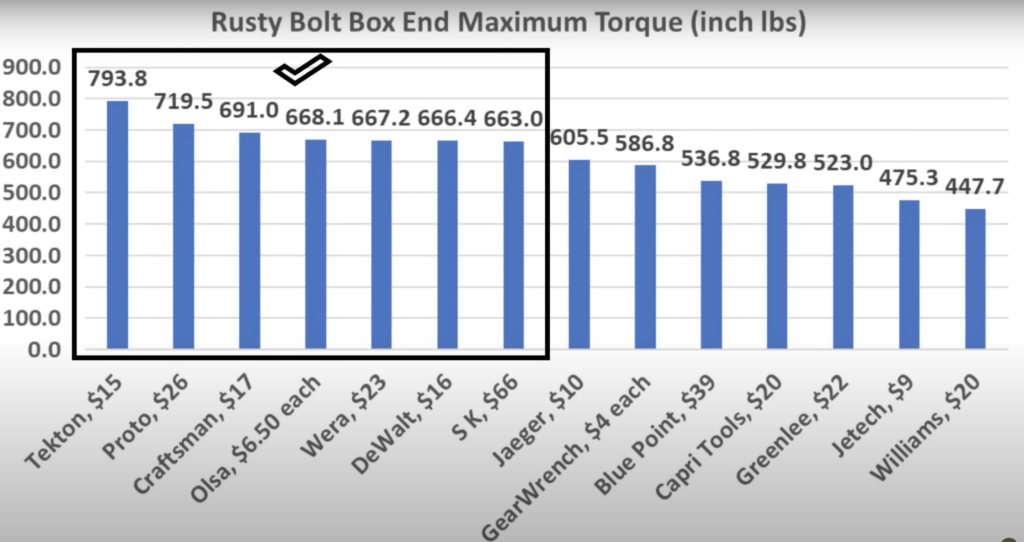
Olsa, Tekton, and Greenlee also performed well at over 600-inch pounds.
I put together a tester and will use some soft coupling nuts to see how much torque each wrench can handle before rounding the fastener or the ratchet fails.
With the entire 12-point box in contact with the nut, the GearWrench broke before it rounded the nut at 329 pounds. And there’s a minimal amount of damage to the nut.
And Olsa claims that their wrenches are made of premium unbreakable steel. And the wrench broke at 514 pounds. In fairness, that’s quite a bit of torque, and everything will bend or break at some point.
And the JetTech seems to be doing just fine, and then things went from happy to snappy at 226 pounds of torque.
Unfortunately, the internal ratcheting mechanism broke. So the JetTech has less than half the strength of the Olsa.
And the Jaeger performed about the same as the GearWrench when the ratcheting mechanism broke at 321 pounds. The coupling nut is still in good shape.
And Tekton performed very closely like the JetTech, with the ratcheting mechanism breaking at 224 pounds.
And the DeWalt held on longer than most other brands, finally breaking at 368 pounds. The coupling nut is still in great shape.
And a Craftsman broke at 415 pounds without any loud bangs or outward visible damage. The coupling nut also experienced quite a bit of damage.
And the Williams performed about the same as the GearWrench and the Jaeger at 325 pounds. The resting gear fell off the Williams.
And it will be almost impossible for a six-point to round the nut, and the Capri wrench broke at 302 pounds, and the coupling nut looks as good as new.
And the Greenlee held on for quite a while and experienced quite a bit of rotation before finally breaking 371-pound, which is like the DeWalt.
And there’s quite a bit of damage to the coupling nut. And the Wera emitted just about 400 pounds when the ratchet broke. Unfortunately, the ratchet gear is now stuck on the coupling nut.
And the Proto made it to 341 pounds, which is about the same as the GearWrench, Jaeger, and Williams, and there’s just a tiny amount of damage to the coupling nut.
And the Snap-on Blue Point performed nearly the same as the Proto at 336 pounds before sparks began flying when the ratchet broke—just a tiny amount of damage to the nut.
And a six-point SK is the heaviest wrench and is built like a tank, even at around 500 pounds. The SK is barely bending. And the metal on the ratchet finally broke at 531 pounds. The nut did experience some damage.
The failure load of a wrench might be something to consider if there’s ever a chance you’ll need to push the ratchet to the limit. And the SK is adamant and came out on top at 531 pounds.
The Olsa also performed well at 514, Craftsman at 415, and Wera at 396. 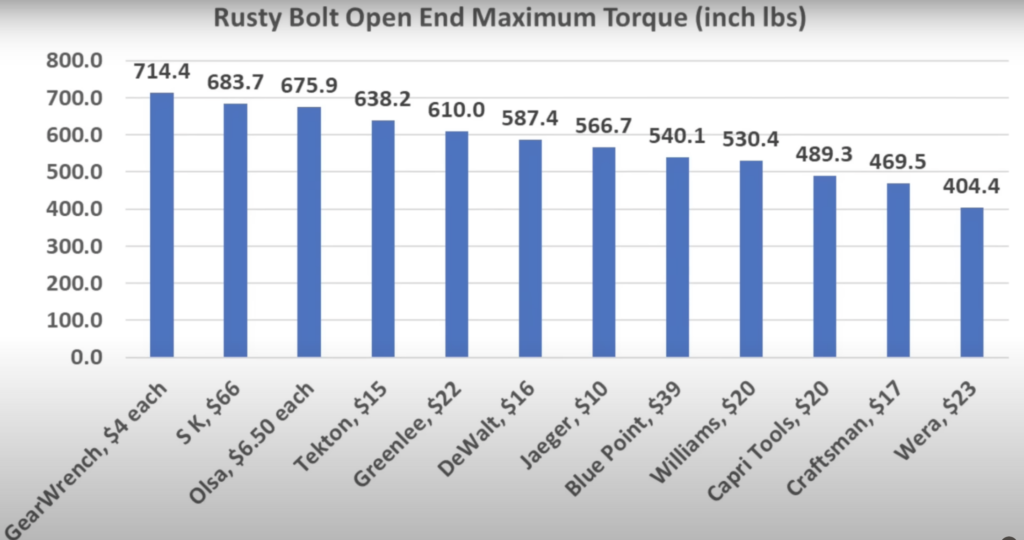
Olsa, Tekton, and Greenlee also performed well at over 600-inch pounds.
I put together a tester and will use some soft coupling nuts to see how much torque each wrench can handle before rounding the fastener or the ratchet fails.
With the entire 12-point box in contact with the nut, the GearWrench broke before it rounded the nut at 329 pounds. And there’s a minimal amount of damage to the nut.
And Olsa claims that their wrenches are made of premium unbreakable steel. And the wrench broke at 514 pounds. In fairness, that’s quite a bit of torque, and everything will bend or break at some point.
And the JetTech seems to be doing just fine, and then things went from happy to snappy at 226 pounds of torque.
Unfortunately, the internal ratcheting mechanism broke. So the JetTech has less than half the strength of the Olsa.
And the Jaeger performed about the same as the GearWrench when the ratcheting mechanism broke at 321 pounds. The coupling nut is still in good shape.
And Tekton performed very closely like the JetTech, with the ratcheting mechanism breaking at 224 pounds.
And the DeWalt held on longer than most other brands, finally breaking at 368 pounds. The coupling nut is still in great shape.
And a Craftsman broke at 415 pounds without any loud bangs or outward visible damage. The coupling nut also experienced quite a bit of damage.
And the Williams performed about the same as the GearWrench and the Jaeger at 325 pounds. The resting gear fell off the Williams.
And it will be almost impossible for a six-point to round the nut, and the Capri wrench broke at 302 pounds, and the coupling nut looks as good as new.
And the Greenlee held on for quite a while and experienced quite a bit of rotation before finally breaking 371-pound, which is like the DeWalt.
And there’s quite a bit of damage to the coupling nut. And the Wera emitted just about 400 pounds when the ratchet broke. Unfortunately, the ratchet gear is now stuck on the coupling nut.
And the Proto made it to 341 pounds, which is about the same as the GearWrench, Jaeger, and Williams, and there’s just a tiny amount of damage to the coupling nut.
And the Snap-on Blue Point performed nearly the same as the Proto at 336 pounds before sparks began flying when the ratchet broke—just a tiny amount of damage to the nut.
And a six-point SK is the heaviest wrench and is built like a tank, even at around 500 pounds. The SK is barely bending. And the metal on the ratchet finally broke at 531 pounds. The nut did experience some damage.
The failure load of a wrench might be something to consider if there’s ever a chance you’ll need to push the ratchet to the limit. And the SK is adamant and came out on top at 531 pounds.
The Olsa also performed well at 514, Craftsman at 415, and Wera at 396. 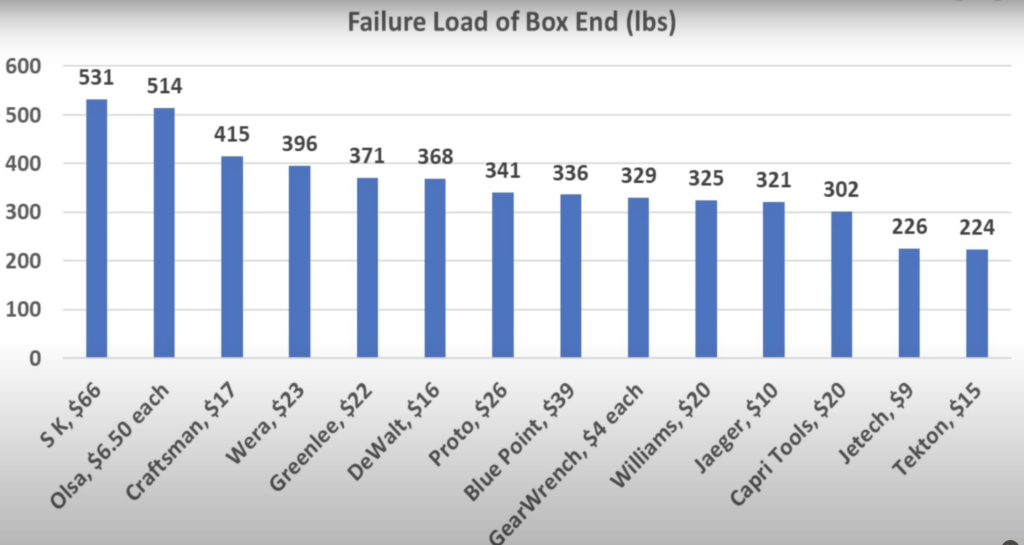
Let’s test the open-end strength of the wrenches using a piece of Allen key made of tough tool steel. The wrenches will either Bend or break before the Allen key essential experiences damage.
And the open end of the gear wrench seems very well designed, making it 1128 inch pounds before giving up. And the open end of the wrench is almost stressed to 9/16.
And the Olsa came up about 200-inch pounds short of the GearWrench at 870 before letting go. And the wrench experience quite a bit of damage. And the JetTech moves into the lead at 1233-inch pounds.
However, the wrench experience quite a bit of damage. And the Jaeger performed even better than the JetTech at 1290-inch pounds. And the Jaeger has even more damage than the JetTech.
And the Tekton has plenty of open-end jaw strength, finally letting go at the 1173-inch pound. Like the other brands, the Jaws are soft and experience quite a bit of bending.
And the open end of the DeWalt is narrower than some of the other brands. And the DeWalt gave up early at an 856-inch pound.
And the Craftsman held on quite a bit longer than the DeWalt, but it finally slipped at 1058-inch pounds. There’s quite a bit of damage to the Craftsman.
And the Williams is performed about the same as the Craftsman at 1033-inch pounds. And Williams has a lot of damage to the lower jaw.
And the Capri Tool is almost a match to the performance of the Williams at 1018-inch pounds. There’s quite a bit of damage to both the upper and the lower jaws.
And the Greenlee moves into the lead at a 1311-inch pound before giving up. Even with the high torque load, the Greenlee has held up better than most other brands.
And the Wera gave up much sooner than most other brands at 866-inch pounds. Both the upper and the lower Jaws experience quite a bit of damage.
And the Proto performed very close to average at 1045-inch pounds. Both the upper and the lower Jaws experience quite a bit of damage.
And the Blue Point gave up a little bit sooner than most other brands at 945-inch pounds, and there’s a big gouge in the lower jaw.
And the SK has a much more compact outer diameter jaw than the competition. Unfortunately, the upper jaw and the SK broke at 836.8-inch pounds.
The Jaws are made of tough steel with no visible gouges.
If you’re looking for a wrench to take the most abuse, the Greenlee came out on top at 1311-inch pounds. The Jaeger did almost as well at the 1290-inch pound, The JetTech at 1233-inch pounds, and Tekton at 1173-inch pounds. 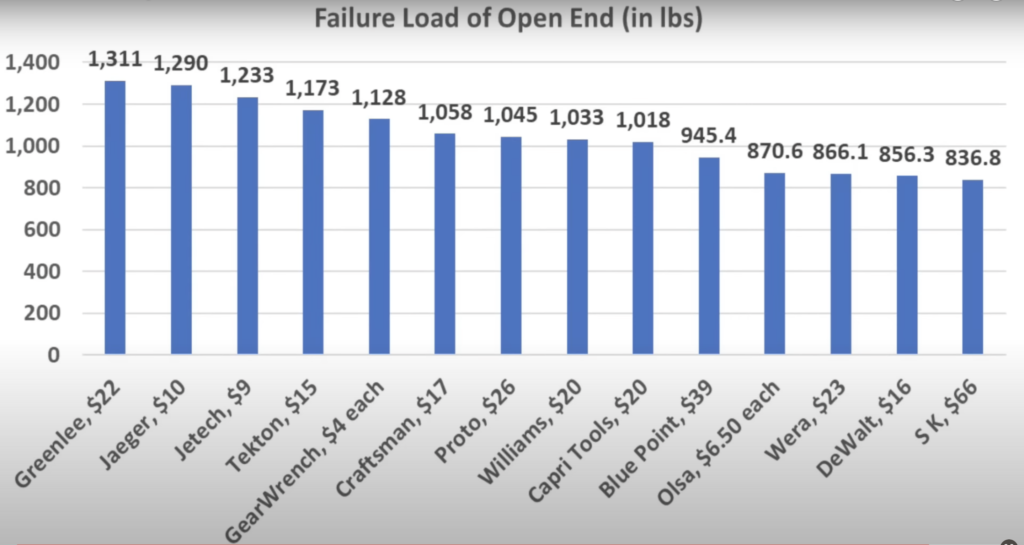
If you’re working in a tight space, the outer diameter of the box end could sometimes be an issue. The Williams, Blue Point, and SK are the most compact at 0.98 inches. The Wera and the Proto were right at 0.99.
The outer diameter of the open end can also be an issue at times, and the SK has a massive advantage over the other brands with an outer diameter of only 0.97 inches, the Blue Point is 1.01 inches, and the Williams at 1.02 inches, and the Proto at 1.06 inches.
And the SK wrench came out on top with an average finish of 3.67 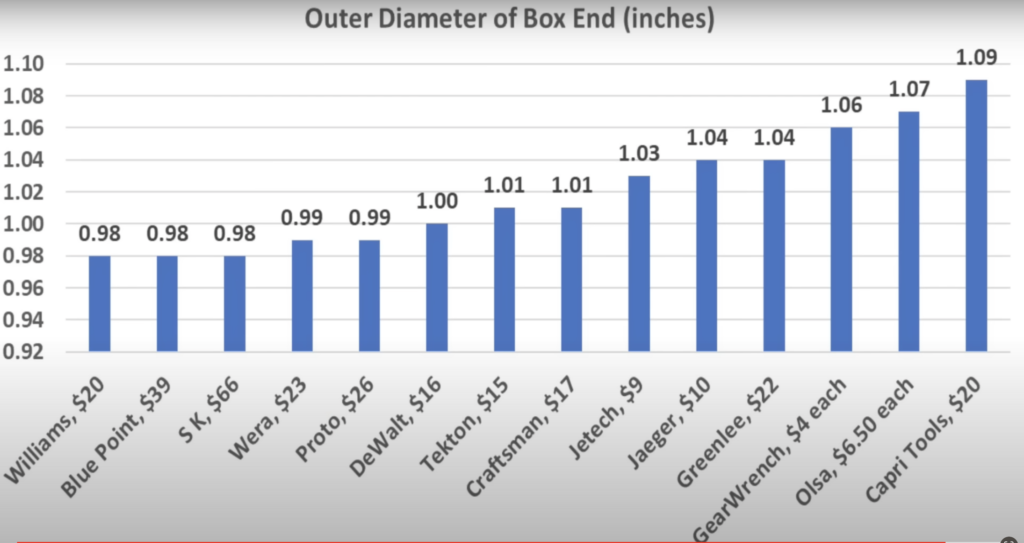
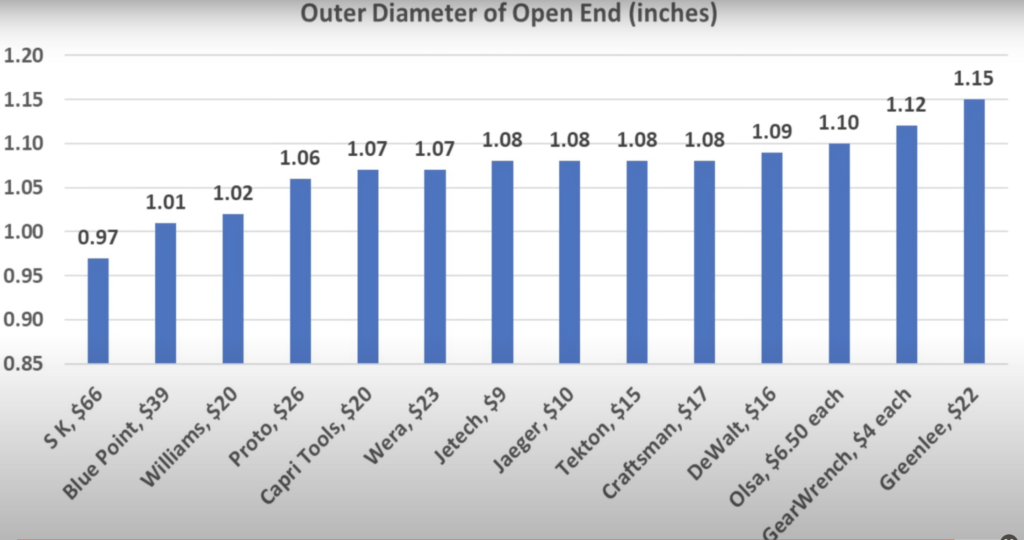
Considering the affordable price, the GearWrench performed well, with an average finish of 4.5 and Tekton at 5.17.
If one throws out the last two tests, the failure load testing, the SK had an average finish of 1.75, and the GearWrench and Tekton also performed very well with an average finish of 3.25 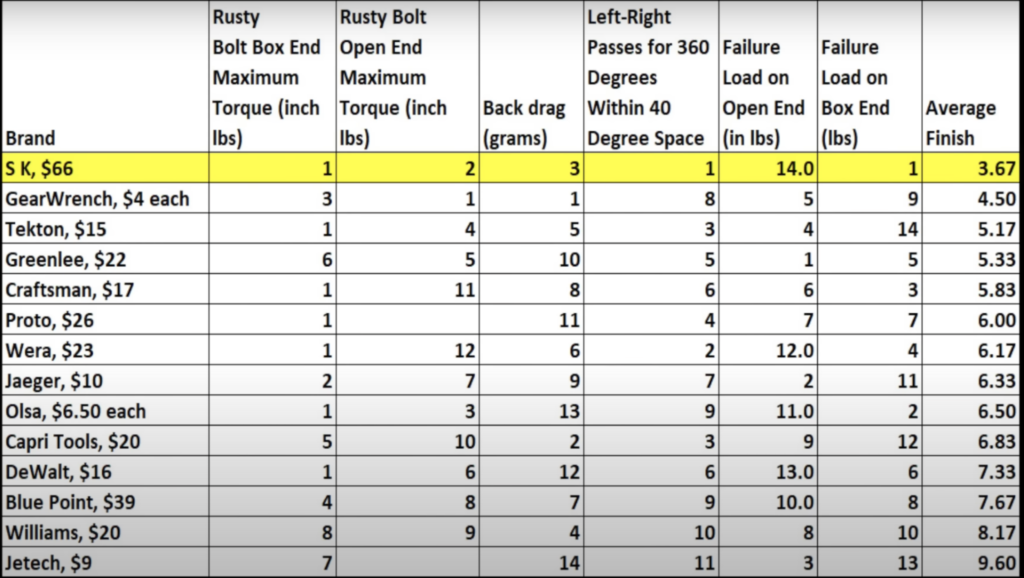

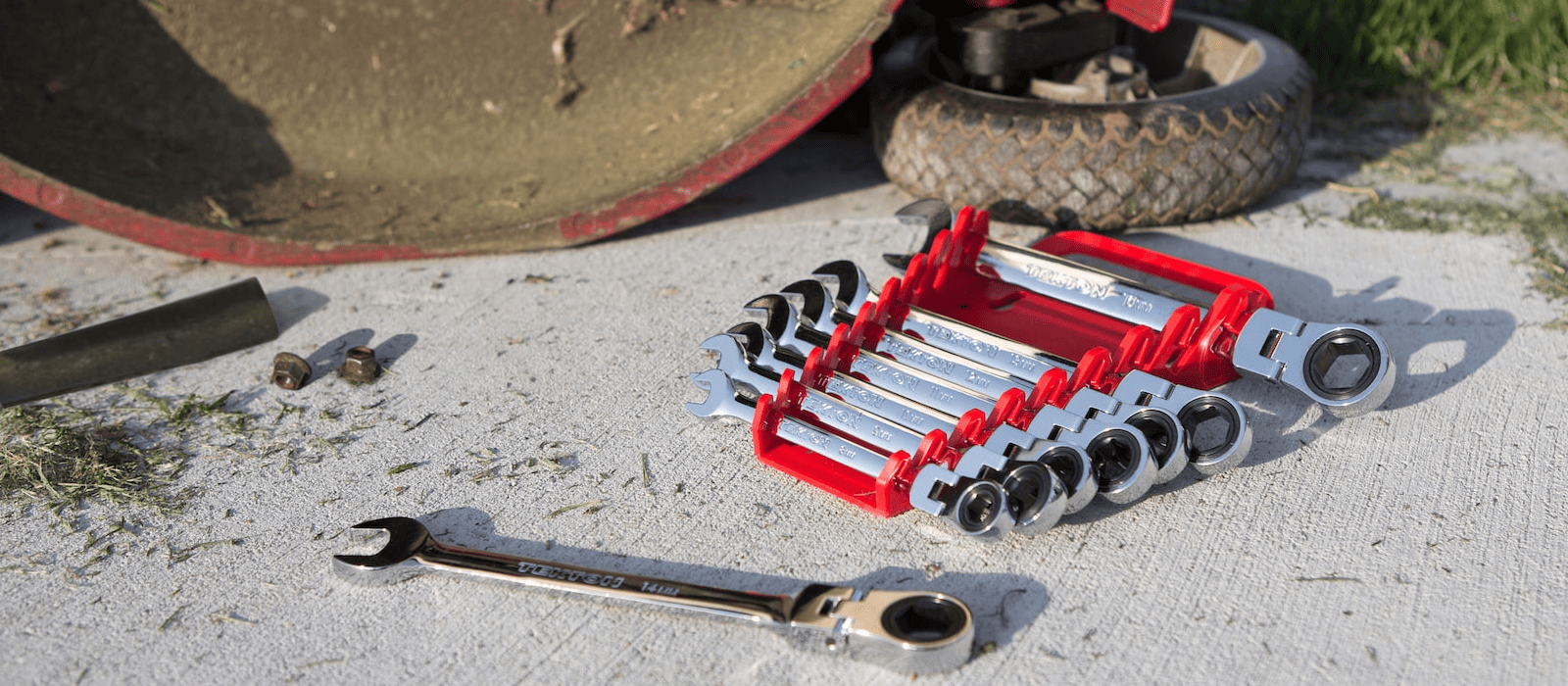
Leave a Reply